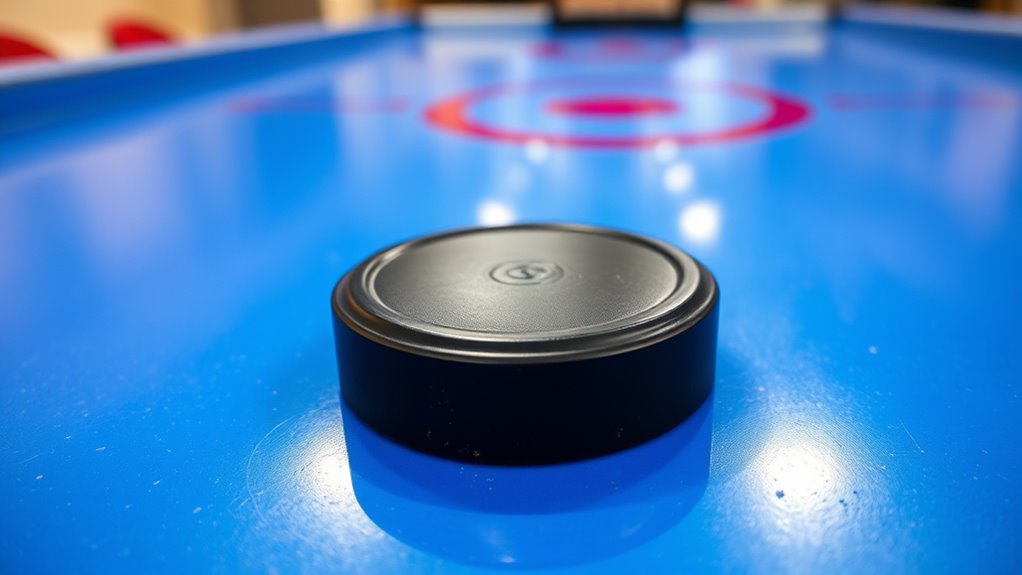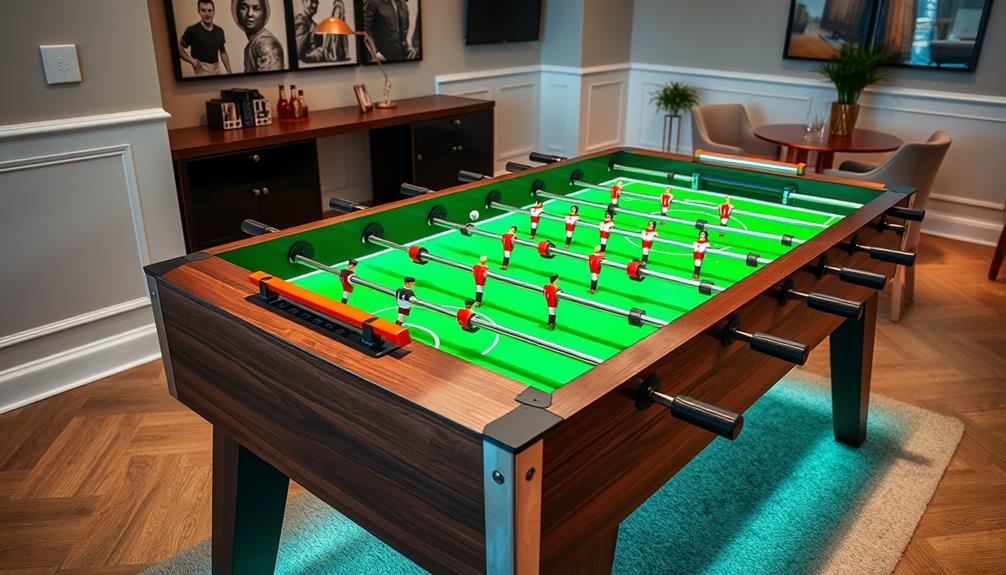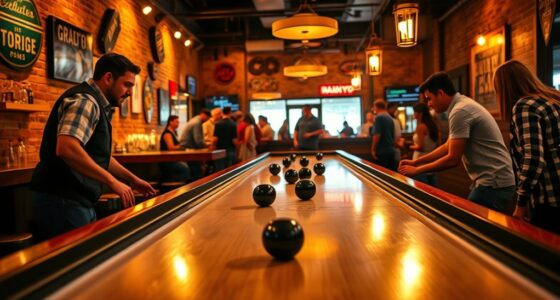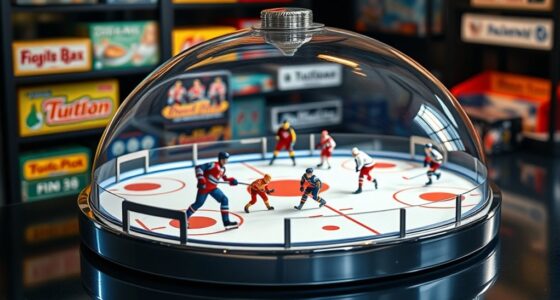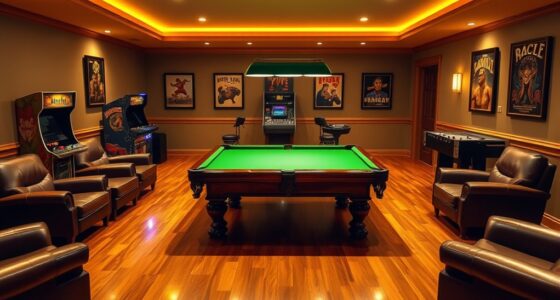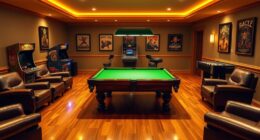To enhance your air hockey game, understand how puck dynamics and table maintenance impact performance. Spin, weight, and surface cleanliness influence puck speed and control, while proper airflow and even surface conditions reduce friction and improve glide. Regularly check for puck damage and keep the table surface clean and flat. Proper maintenance helps make certain of consistent, fast, and accurate gameplay. Keep exploring further tips to maximize your skills and enjoy smoother play.
Key Takeaways
- Regularly inspect and clean the air hockey table surface to ensure smooth puck glide and prevent debris buildup.
- Maintain consistent airflow by checking air jets and cleaning vents to reduce surface friction.
- Use correctly weighted and smooth pucks to optimize speed, control, and trajectory during play.
- Check for surface damage or scratches on pucks and table to prevent irregular movement and improve gameplay.
- Schedule routine maintenance, including surface cleaning and equipment inspection, to ensure optimal puck dynamics and table performance.
The Physics Behind Puck Movement
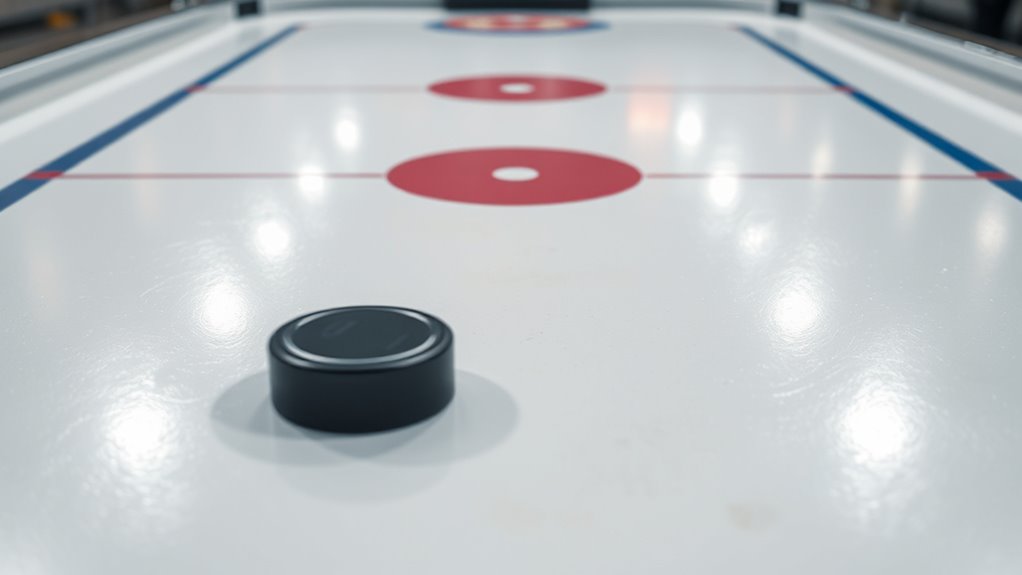
Understanding the physics behind puck movement is essential to mastering air hockey. When you strike the puck, its spin influences how it glides across the table, affecting control and accuracy. A puck with a spin creates a friction difference, causing it to curve or change direction unexpectedly. Additionally, table lighting plays a crucial role; proper illumination highlights the puck’s movement, allowing you to anticipate its path better. Bright, even lighting reduces shadows and glare, ensuring you see the puck clearly. Using air purification technology in the room can also contribute to a more comfortable environment, helping you stay focused during gameplay. By controlling puck spin and paying attention to table lighting, you improve your gameplay. Recognizing how these factors interact helps you develop better shots and defensive plays, giving you an edge in the game. Mastering these physics principles makes your moves more precise and confident.
Factors Affecting Puck Speed and Trajectory
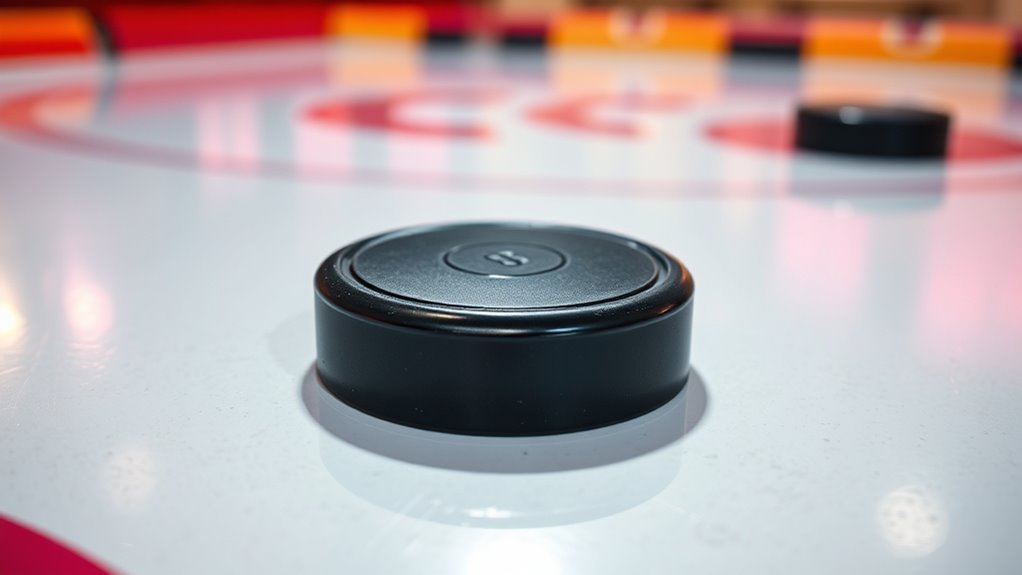
Several factors directly influence the puck’s speed and trajectory during an air hockey game. Puck weight plays a vital role; lighter pucks accelerate faster but are more affected by surface irregularities. Additionally, table temperature impacts airflow and puck glide. Warmer tables can cause the puck to move unpredictably, while cooler surfaces promote consistent movement. Consider the table’s influence on your gameplay with this table:
| Factor | Effect | Emotional Impact |
|---|---|---|
| Puck Weight | Faster acceleration or sluggishness | Frustration or satisfaction |
| Table Temperature | Affects airflow and glide | Surprise or calmness |
| Surface Consistency | Smooth or rough surface alters paths | Confidence or doubt |
A proper understanding of airflow dynamics can help optimize puck movement and improve overall gameplay.
The Role of Surface Friction and Air Flow
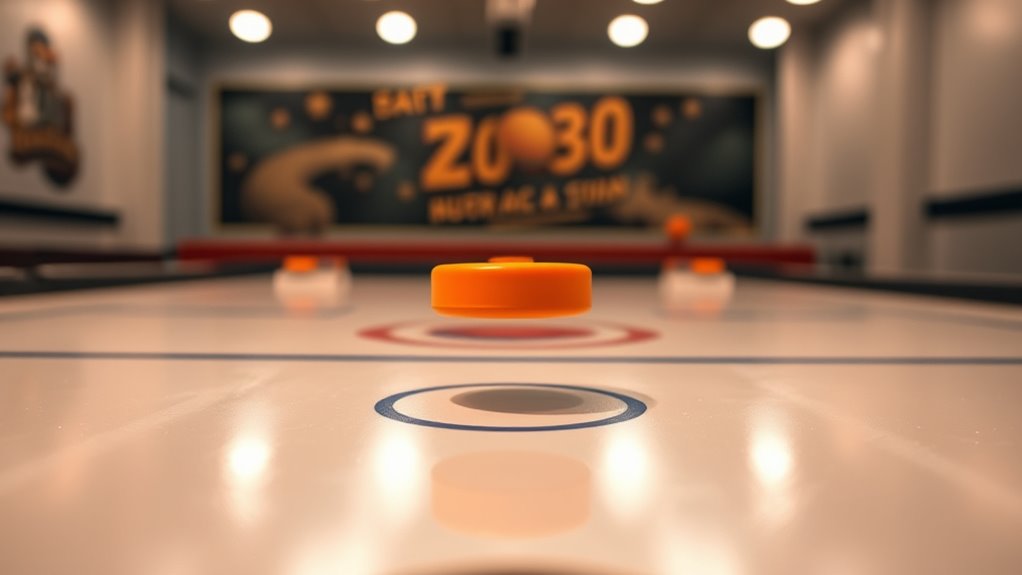
Surface friction and airflow are key elements that directly influence how the puck moves across the table. The air flow patterns created by the table’s air jets generate a cushion that reduces surface friction effects, allowing the puck to glide smoothly. When the air flow is even and well-maintained, you’ll notice less resistance, which promotes faster, more precise movements. Conversely, dirt or debris can disrupt these air flow patterns, increasing surface friction and slowing down the puck. Maintaining a clean surface and ensuring the air system functions properly are essential for peak play. Properly designed air flow systems help in minimizing surface friction effects, leading to a more consistent game. By understanding how air flow patterns affect surface friction effects, you can better control the puck’s speed and trajectory, making your game more consistent and enjoyable.
Signs of Wear and Damage on the Puck
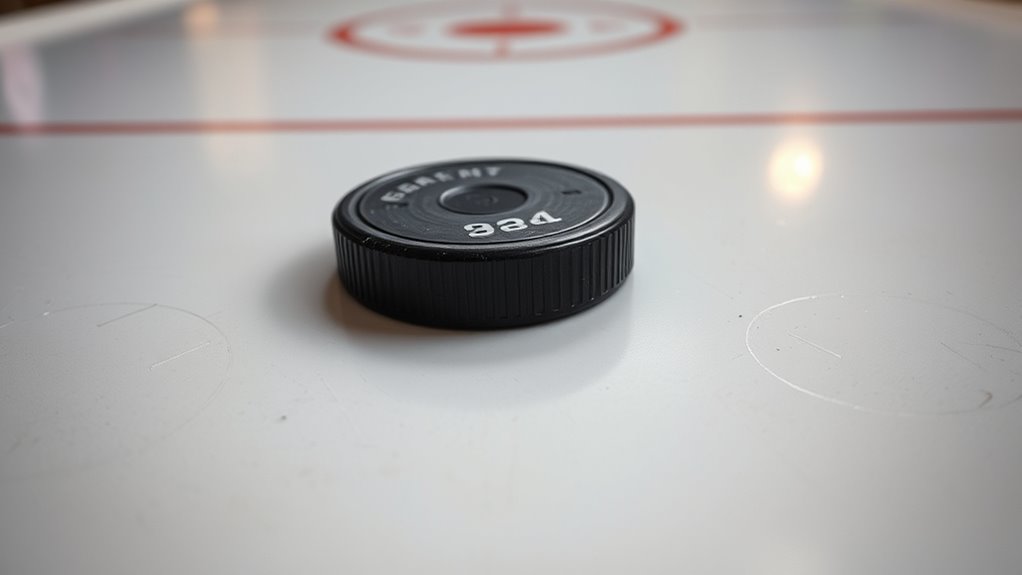
Keep an eye out for visible surface scratches, which can affect your puck’s smooth glide. Dented or warped edges are signs that the puck has taken a hit and may not perform properly. If you notice a decline in glide performance, it’s likely time to inspect the puck for these types of damage. Regular maintenance and understanding industry transformations can help extend the lifespan of your hockey puck.
Visible Surface Scratches
Have you ever noticed tiny scratches on your air hockey puck after a game? These surface scratches are common signs of wear and damage. They often appear on the puck surface, indicating frequent contact with the table’s surface. Scratches can affect puck glide and table alignment, leading to unpredictable gameplay. To visualize, consider this table:
| Scratch Type | Appearance | Effect |
|---|---|---|
| Light Surface | Fine, shallow lines | Slight impact on puck speed |
| Deep Gouges | Noticeable, rough marks | Disrupts puck movement |
| Circular Scratches | Rings or spirals | Alters puck trajectory |
| Crosshatch | Intersecting lines | Affects puck smoothness |
| Multiple Small | Numerous tiny scratches | Gradual surface degradation |
Regularly inspecting and maintaining the puck surface helps preserve ideal table alignment and gameplay quality. Additionally, understanding vibrational energy can help improve your maintenance routine and prolong the lifespan of your puck.
Dented or Warped Edges
Dented or warped edges on your air hockey puck are clear signs of wear that can substantially impact gameplay. Puck deformation, caused by frequent impacts or rough handling, leads to uneven surfaces and affects how the puck glides and reacts on the table. Edge warping, in particular, alters the puck’s shape, making it less predictable during play. When edges become bent or misshapen, you’ll notice irregular bounces and inconsistent movement, hampering accuracy and control. These deformities not only diminish gameplay quality but can also accelerate further damage if left unaddressed. Regularly inspecting your puck for dents or warping helps you catch issues early, ensuring *best* performance. Replacing a damaged puck or repairing minor deformities can restore smooth gameplay and prolong the life of your equipment.
Reduced Glide Performance
Reduced glide performance is a clear indicator that your air hockey puck is experiencing wear or damage. Over time, the puck material can become rough or develop small nicks, which increase friction and slow its movement. Additionally, dirt, dust, or debris on the table surface can hinder smooth gliding. If the table isn’t kept clean, particles can stick to the puck or create uneven contact, reducing its speed. Check the puck for signs of scratches, cracks, or warping, which also hinder performance. Replacing worn pucks and maintaining table cleanliness are key steps to guarantee ideal glide and gameplay. Regular cleaning of the table surface and inspecting the puck material can prevent reduced glide performance and keep your game fast and smooth. Proper maintenance can significantly extend the lifespan of both your puck and table, ensuring consistent performance.
Proper Maintenance of the Air Hockey Table
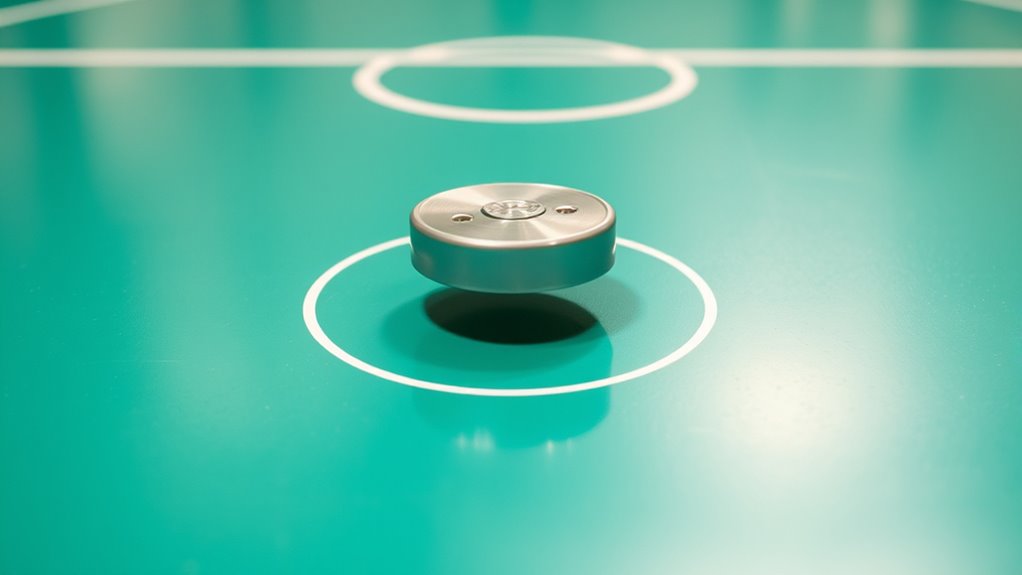
Wondering how to keep your air hockey table in top shape? Proper maintenance starts with checking the puck material; verify it’s smooth and free of cracks, which can affect glide and gameplay. Regularly clean the table surface with a soft cloth to remove dust and debris that can cause uneven puck movement. Pay close attention to table alignment—an uneven surface can lead to unpredictable puck behavior and faster wear. Adjust the legs or frame as needed to keep the surface perfectly level. Protect the table from moisture and extreme temperatures, which can warp the playing surface. Additionally, examining the puck material periodically ensures it remains optimal for play. Consistent upkeep not only enhances game quality but also extends your table’s lifespan. With diligent care, your air hockey table will deliver smooth, fast gameplay every time.
Tips for Enhancing Gameplay Through Table Care
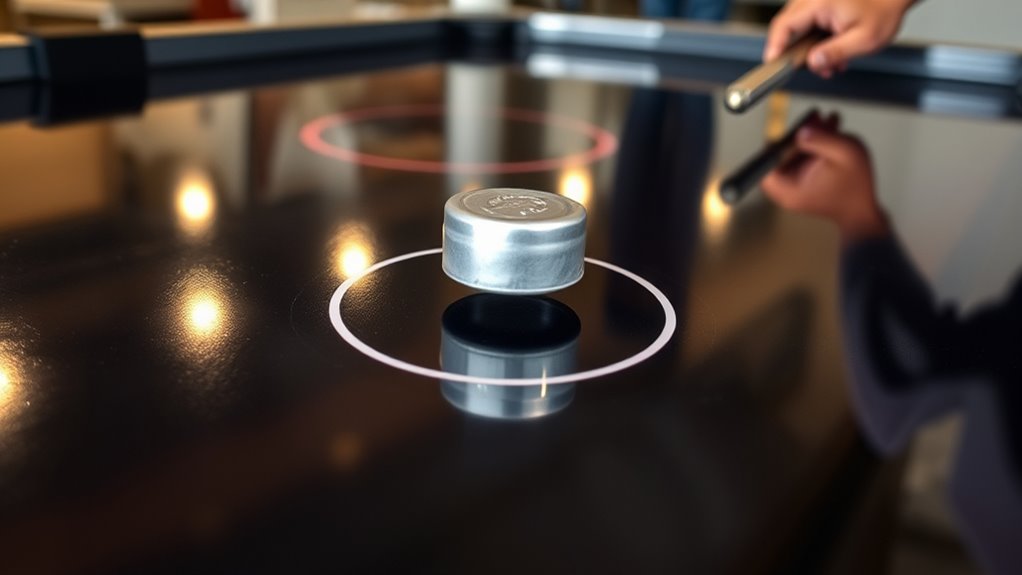
Maintaining your air hockey table properly can substantially improve gameplay by ensuring a smooth and consistent playing surface. Regular table cleaning techniques remove dust and debris that cause friction, helping pucks glide faster and straighter. Also, consider puck customization to enhance your game—adjusting puck weight or surface can improve control. Keep a cleaning schedule and use gentle, non-abrasive cleaners to prevent damage. For better puck performance, check for smooth edges and replace worn pucks promptly. Here’s a quick guide:
| Maintenance Tip | Benefit |
|---|---|
| Regular table cleaning | Ensures smooth puck movement |
| Use proper cleaning techniques | Prevents surface damage |
| Customize pucks | Improves control and speed |
| Replace worn pucks | Maintains consistent gameplay |
| Check table surface regularly | Keeps surface even and flat |
A regular maintenance routine helps prevent costly repairs and keeps the playing surface in optimal condition, which is essential for consistent gameplay.
Frequently Asked Questions
How Often Should I Replace the Air Hockey Puck?
You’re wondering how often to replace your air hockey puck. Puck replacement frequency depends on usage and signs of worn puck. Typically, you should replace it when it becomes chipped, cracked, or loses its smooth surface, impacting gameplay. If you notice the puck skews or doesn’t glide well, it’s time for a new one. Regularly inspecting your puck ensures peak performance and prolongs your table’s life.
What Materials Best Prevent Puck Damage Over Time?
When choosing materials to prevent puck damage over time, focus on durability and low surface friction. You want a material that resists wear and tear, like high-quality plastic or composite. These materials reduce friction, minimizing impact from repeated hits and prolonging the puck’s lifespan. By selecting durable, low-friction materials, you guarantee smoother gameplay and less frequent replacements, keeping your air hockey experience fun and hassle-free.
Can Temperature Affect Puck Performance and Table Maintenance?
You should consider how puck temperature and table humidity impact performance and maintenance. When puck temperature rises, it can become less responsive, especially if the puck is too warm or cold. High table humidity can cause the surface to become sticky or uneven, affecting glide. Keep the puck at a consistent temperature and control humidity levels to guarantee smooth gameplay and easier table upkeep. Proper maintenance minimizes damage and prolongs your table’s lifespan.
How Do Table Cleaning Routines Influence Puck Lifespan?
Imagine you clean your air hockey table regularly, say weekly, to maintain ideal surface texture. Frequent cleaning removes debris and oils that can cause puck friction, reducing wear and tear. A case study shows that tables cleaned monthly experience puck lifespan issues sooner than those cleaned weekly. So, your cleaning frequency directly impacts puck durability, ensuring smoother gameplay and longer-lasting equipment.
Are There Specific Lubricants Recommended for Table Maintenance?
When considering table cleaning and lubricant selection, you want to keep the surface smooth and free of debris. Use a lubricant specifically designed for air hockey tables, often silicone-based, to guarantee minimal friction and ideal puck glide. Avoid oil-based lubricants, as they can damage the table surface. Regular cleaning combined with the right lubricant helps maintain table condition, prolongs puck lifespan, and keeps gameplay smooth and enjoyable.
Conclusion
By understanding how puck physics and table maintenance work together, you’ll play smoother and longer. Think of your table like a well-tuned racecar—small tweaks in surface care or puck condition can make all the difference. When I cleaned my table, my shots became sharper, like a finely honed blade. Keep an eye on wear and stay proactive with maintenance, and you’ll enjoy game after game, just like a champion hitting their stride.
